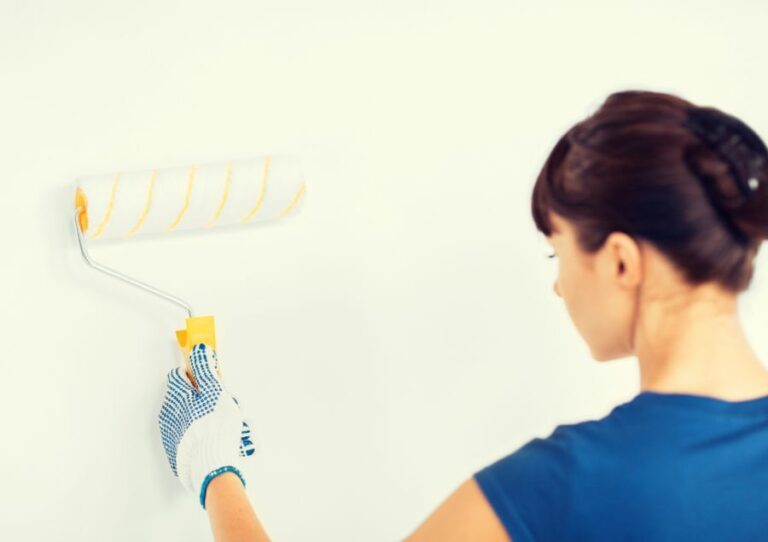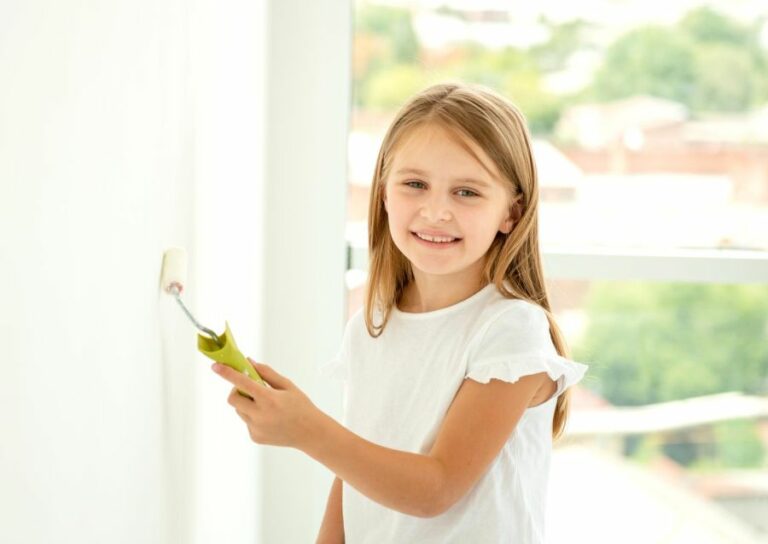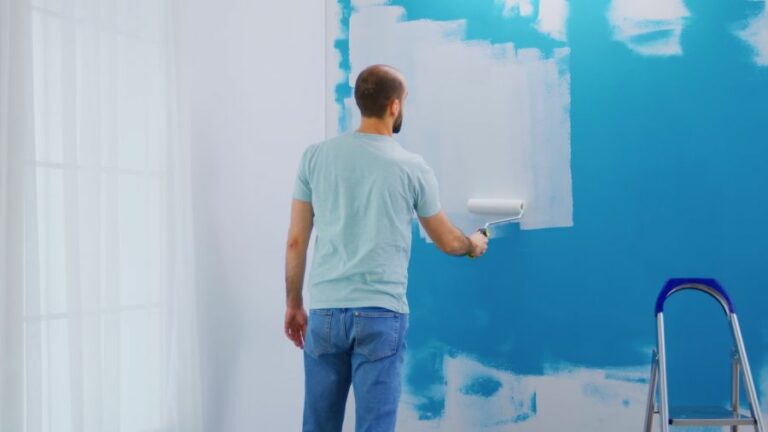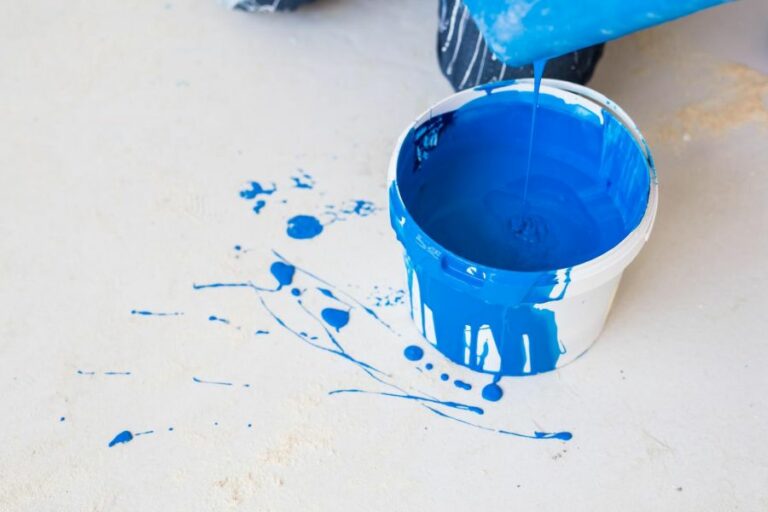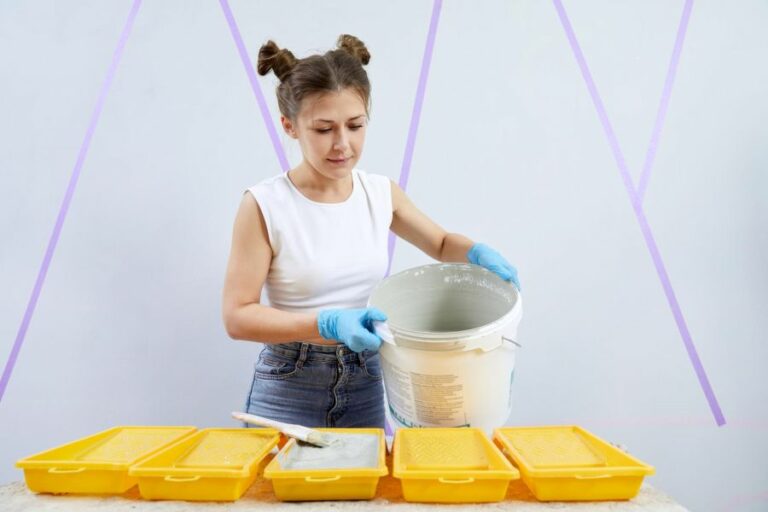Indoor Paint Finishes: Matte, Satin, and Glossy. What Pros Say
Undoubtedly, choosing the perfect paint finish for your indoor spaces can greatly impact the overall look and feel of your home. You may have asked yourself: Should I go for a matte, satin, or glossy finish? Well, worry no more; we’re here to guide you in selecting the most suitable indoor paint finish for your specific needs.
Indoor paint finishes (matte, satin, glossy):
Indoor paint finishes include matte, satin, and glossy. A matte finish with minimal sheen, is ideal for creating a calm ambiance and hides imperfections. Satin finish has a soft, velvety appearance, balancing durability and style, perfect for high-traffic areas. The glossy finish offers a smooth, reflective surface for an elegant look and is highly durable and moisture-resistant, suitable for kitchens and bathrooms.

Discover the world of indoor paint finishes and learn how to choose the perfect one for your space. Explore the differences between matte, satin, and glossy finishes, understanding their benefits and drawbacks.
Read on as we delve into their unique characteristics and give expert advice for selecting the ideal finish for your walls.
Contents
- 1 Interior Paint Finishes: Matte, Satin, and Glossy Explained
- 2 Discovering the Ideal Paint Finish for Interior Walls
- 3 Choosing Between Flat or Satin Interior Wall Paint
- 4 Comparing Matte, Satin, and Gloss Paint Finishes
- 5 Understanding Paint Sheen Hierarchy and Differences
Interior Paint Finishes: Matte, Satin, and Glossy Explained
Choosing the right paint finish for your interior walls is crucial to achieving the desired outcome. Not only does it affect the overall aesthetics, but it also plays a significant role in the room’s durability and maintenance.
• Matte Finish
Matte paint finish, also known as a flat finish, has a non-reflective appearance due to its minimal sheen. It is an excellent choice for rooms where you want to create a calm and soothing ambiance. Matte finish paint provides a subtle touch, effortlessly hiding imperfections on the wall surface.
– Pros of Matte Finish
- Hides imperfections: Its non-reflective nature helps to camouflage small wall blemishes and uneven patches.
- Easy touch-ups: Matte finish paint blends seamlessly during touch-ups, making it simple to maintain the wall’s pristine appearance.
– Cons of Matte Finish
- Easily scuffed: Its soft texture makes matte paint more prone to scuffs and marks.
- Less washable: The surface tends to retain moisture, making it challenging to remove dirt and stains.
– Recommended Uses for Matte Finish
- Bedrooms, as it creates a restful atmosphere
- Ceilings, to diminish attention
- Living and dining rooms
- Accent walls
• Satin Finish
Satin finish paint, also known as an eggshell finish, strikes a perfect balance between matte and glossy finishes.
With a soft, velvety appearance, the satin finish provides a hint of sheen that subtly reflects light. It is more durable than matte paint and is an excellent choice for high-traffic areas where frequent cleaning is required.
– Pros
- Durable: More resistant to wear and tear than matte paints, satin finish is a long-lasting option.
- Washable: Its slightly reflective surface makes it easier to clean dirt and stains.
– Cons
- Shows imperfections: The subtle sheen is less forgiving on wall irregularities and blemishes.
- Difficult touch-ups: The slight gloss can make touch-ups more noticeable.
– Recommended Uses
- Kitchens, as it withstands frequent cleaning
- Bathrooms, due to their moisture resistance
- Entryways and hallways
- Family rooms and playrooms
• Glossy Finish
Glossy paint finish, which includes semi-gloss and high-gloss finishes, provides a smooth and reflective surface. It delivers a dramatic and elegant appearance that captures light effectively.
Glossy finishes are highly durable and resistant to moisture, making them perfect for areas requiring frequent cleaning and moisture resistance.
– Pros
- Highly durable: Glossy paints are resilient and long-lasting, excellent for high-traffic areas.
- Easy to clean: The shiny surface easily repels dirt, stains, and moisture.
- Enhances architectural details: The reflective quality highlights moldings, wainscoting, and other intricate features.
– Cons
- Shows imperfections: The shiny surface magnifies wall surface blemishes.
- Requires diligent prep work: Due to its reflective nature, thorough wall preparation is necessary to achieve a smooth finish.
– Recommended Uses
- Kitchens and bathrooms, as it withstands moisture
- Doors and trim
- Cabinets and furniture
- Highlighting architectural features
In conclusion, understanding the differences between matte, satin, and glossy paint finishes will enable you to select the appropriate finish for your project. It is crucial to consider factors such as room functionality, desired ambiance, and wall condition when determining the ideal paint finish.
For further guidance, visit the United States Environmental Protection Agency for valuable resources on indoor air quality influenced by paint selections.
Discovering the Ideal Paint Finish for Interior Walls
Selecting the ideal paint finish for your interior walls depends on various factors, such as the room’s purpose, the amount of traffic, and the desired aesthetic.
With several types of paint finishes available, making the right choice can transform the appearance of your interior while ensuring durability and easy maintenance.
– Matte and Matte Enamel Paint Finishes
Matte and matte enamel paints are known for their smooth, non-reflective finish. They effectively hide imperfections on walls and ceilings, making them popular for most interior spaces. These finishes work well in living rooms, bedrooms, and dining areas.
Pros:
- Excellent coverage of wall imperfections
- Great for walls with visible texture or rough surfaces
- Wide range of color options
Cons:
- Less durable than other finishes
- May require multiple coats to achieve even coverage
Matte enamel is a more durable alternative to regular matte paint, making it ideal for high-traffic areas like kitchens, bathrooms, and children’s rooms. Additionally, it’s easier to clean than matte paint, which can be essential in these spaces.
– Eggshell Paint Finish
The eggshell finish strikes a balance between matte and glossy finishes. It has a subtle sheen, offering a low-level shine that enhances the wall’s texture without being too reflective.
This finish is perfect for living rooms, bedrooms, and hallways since it is more durable and easier to clean compared to matte paint. The eggshell’s light sheen also creates a more elegant and sophisticated appearance.
Pros:
- Moderately washable and durable
- Hides minor wall imperfections
- Less prone to paint roller marks
Cons:
- May require multiple coats for even coverage
- Can emphasize surface imperfections in certain lighting conditions
– Satin Paint Finish
A satin finish is characterized by a soft, velvety sheen that adds depth and warmth to walls. It is more durable and easier to clean than eggshell or matte finishes, making it perfect for high-traffic areas.
Suitable for children’s rooms, kitchens, bathrooms, and hallways, the satin finish resists mildew, dirt, and stains effectively while maintaining an attractive appearance.
Pros:
- Highly durable and resistant to wear
- Mold and mildew resistant
- Easy to clean and maintain
Cons:
- Difficult to touch up or repair
- Can accentuate surface imperfections
– Semi-Gloss and Glossy Paint Finishes
Semi-gloss and glossy finishes offer high reflectivity, creating a shiny and polished appearance. They are ideal for highlighting architectural features, such as doors, window frames, and molding.
Semi-gloss and glossy finishes are recommended for high-traffic and utility areas due to their durability and ease of cleaning. They work well in kitchens, bathrooms, laundry rooms, and playrooms.
Pros:
- Highly durable and resistant to moisture
- Easy to clean and maintain
- Brightens up the room
Cons:
- May require multiple coats for coverage
- Highlights surface imperfections
While semi-gloss and glossy finishes may not be suitable for all wall surfaces, they can dramatically enhance specific parts of your interior.
• Conclusion
Selecting the best paint finish for your interior walls depends on the room’s purpose, amount of traffic, and desired aesthetic.
While matte and matte enamel paint finish provide a smooth, non-reflective surface suitable for most interior spaces, eggshell and satin finishes offer increased durability and a subtle sheen ideal for high-traffic areas.
On the other hand, semi-gloss and glossy finishes provide high reflectivity, making them suitable for emphasizing architectural details and utility spaces.
Consider these factors and the pros and cons of each finish when making your decision. With the right paint finish, you can balance both beauty and practicality for your interior walls.
Type of Paint Finish | Advantages | Disadvantages | Recommended Usage |
|---|---|---|---|
Flat or Matte | Hides imperfections, low reflection | Difficult to clean, not durable | Low-traffic rooms (e.g. bedrooms) |
Eggshell | Hides some imperfections, easy to clean | Some reflection, not as durable as semi-gloss or gloss | Living rooms, dining rooms |
Satin | Smooth finish, easy to clean | Shows imperfections, may require touch-ups | High-traffic areas (e.g. hallways, kids’ rooms) |
Semi-Gloss | Easy to clean, more durable | Shows imperfections, higher reflection | Trim, doors, bathrooms, kitchens |
Gloss | Highly durable, easy to clean | Shows all imperfections, very reflective | Trim, doors, cabinets, furniture |
Choosing Between Flat or Satin Interior Wall Paint
The decision to paint interior walls either flat or satin is one that many homeowners and interior designers face. Each finish has its own set of advantages and disadvantages, and understanding these can help you make the right decision for your specific needs.
• Flat Finish: Pros and Cons
A flat finish, sometimes referred to as a matte finish, is paint with no shine or sheen. This type of finish is quite popular for several reasons.
– Pros of Flat Finish
- Hides imperfections: Flat paint is excellent at hiding surface imperfections, such as cracks, bumps, and small dents. Its non-reflective nature minimizes the appearance of these blemishes, making it easier to achieve a smooth and uniform surface even on older walls.
- Reduced glare: Due to its non-reflective nature, flat paint does not create glare, making it a suitable choice for rooms with a lot of natural light or for walls where artwork or televisions are displayed.
- Ease of touch-up: It is generally easier to touch up flat paint compared to satin, as there’s no sheen to match. This makes maintenance and repairs simpler and less noticeable.
– Cons of Flat Finish
- Durability: Flat paint is generally not as durable as satin paint. It is more susceptible to damage from abrasion, moisture, and cleaning, which can lead to an increased need for maintenance and repainting.
- Stain resistance: Flat paint is not as stain-resistant as satin finishes. This means that it is more likely to show dirt, fingerprints, and other marks, particularly in areas with high foot traffic or children.
• Satin Finish: Pros and Cons
Satin finish, sometimes called eggshell or low-luster finish, is a paint with a low-level sheen or gloss. It falls between a flat and semi-gloss finish in terms of shine and offers several advantages and disadvantages.
– Pros
- Durability: Satin paint is generally more durable than flat paint. It is resistant to damage from abrasion, moisture, and cleaning, making it a popular choice for high-traffic areas like hallways, kitchens, and bathrooms.
- Stain resistance: Satin finishes have better stain resistance compared to flat paints, making them easier to clean and maintain.
- Aesthetics: Satin paint provides a subtle sheen, which adds a touch of elegance and depth to your walls without being overly shiny.
– Cons
- Shows imperfections: Due to its light-reflecting properties, satin paint can highlight imperfections on wall surfaces, such as cracks, bumps, or uneven patches, more prominently compared to a flat finish.
- Touch-ups: Matching the sheen level of satin paint during touch-ups can be challenging, and touch-up marks may be more visible compared to those on flat paint.
• Making the Decision: Flat or Satin?
The final decision on whether to use flat or satin paint for your interior walls will largely depend on your priorities and the specific requirements of your space. Here are some recommendations based on our experience:
- For older homes or walls with imperfections: A flat finish is your best option, as it will hide imperfections and allow you to achieve a smooth surface.
- For spaces with high traffic, moisture, or a need for easy cleaning: A satin finish is recommended, as it offers better durability and stain resistance, and is easier to clean compared to flat paint.
- For rooms with a lot of natural light or wall decorations: Consider using flat paint to minimize glare and provide an even backdrop for your artwork or displays.
To summarize, flat paint offers a non-reflective finish that hides imperfections well but is less durable and stain-resistant than satin paint.
Satin paint provides a subtle sheen that adds elegance to your walls and offers better durability and stain resistance. It is important to consider the specific needs of your space when making this decision.
Comparing Matte, Satin, and Gloss Paint Finishes
When selecting a finish for various materials, whether for photographs, printed materials, or home furnishings, understanding the differences between matte, satin, and gloss finishes can be crucial in achieving the desired aesthetic.
These three finishes offer different levels of shine, reflection, and texture for a range of applications.
• Matte Finish: Aesthetics and Applications
– A Non-Reflective Surface
Matte finish surfaces are characterized by their non-reflective texture, which helps to eliminate glare and reflections. The absence of shine allows for a more even appearance, as it hides imperfections and can be less prone to showing fingerprints or smudges.
– Richness in Color and Detail
One advantage of a matte finish is that it allows for a more accurate representation of color, as the lack of reflection can enhance the depth and richness of images.
This is especially beneficial for photographic prints, as it can result in a smoother transition between colors, improved sharpness, and overall better detail.
– Suitable for a Variety of Applications
Given its non-reflective nature and ability to reproduce colors accurately, matte finishes are ideal for minimizing glare, such as in photography, artwork, or in professional settings like offices and galleries.
Additionally, matte finishes are often preferred for home furnishings and decorations and more casual printed materials like business cards and brochures.
• Satin Finish: A Beautiful Balance
– Shimmer without Shine
Satin finish strikes a balance between the non-reflective matte and highly reflective gloss finishes. It provides a subtle, low-shine surface that still allows for some light reflection, giving the surface a gentle sheen.
– Enhanced Color Depth
Compared to matte finishes, satin offers a slightly enhanced color depth, bringing images to life with added vibrancy. Satin finishes are often considered to be an ideal combination of the color reproduction benefits of matte finishes and the enhanced color depth of gloss finishes.
– Versatile Applications
Satin finishes can be a versatile option to consider for photographs, printed materials, and home furnishings. They are ideal for environments where some reflection is desired, but glare should be minimized, such as residential spaces, lobbies, and reception areas.
Satin finishes combine aesthetics and practicality for a variety of applications.
• Gloss Finish: A Shining Star
– High-Intensity Shine
Gloss finishes are characterized by their highly reflective and shiny surface. This mirror-like quality heightens color intensity and the contrast of images on the surface, making them appear more vibrant and dramatic.
– Enhanced Clarity and Depth
Gloss finishes are known to provide a higher level of clarity and three-dimensional depth to images, as the reflection of light enhances the contrast and color vibrancy. As a result, gloss finishes are often selected for materials and projects where striking visuals and contrast are desired.
– Recommended for Specific Applications
Given the highly reflective nature of gloss finishes, they are best suited for materials and projects where glare is not a concern. Gloss finishes are often preferred for promotional materials, posters, and high-impact photographic prints.
However, it is essential to consider that glossy surfaces may reveal fingerprints and smudges more readily than matte or satin finishes.
• Recommended Applications for Each Finish
While personal preferences and specific applications ultimately dictate the choice of finish, some general recommendations can be made:
- Matte Finish: Ideal for photographic prints, artwork, and printed materials where glare must be minimized, and color accuracy is essential.
- Satin Finish: A versatile option for home furnishings, residential settings, and printed materials where some reflection and enhanced color depth are desired.
- Gloss Finish: Best suited for promotional materials, posters, and high-impact photographs where increased vibrancy, contrast, and clarity are the primary objectives.
In conclusion, understanding the differences between matte, satin, and gloss finishes can impact the end result of your project, whether related to photographs, printed materials, or home furnishings.
By carefully selecting the right finish, you can ensure the best visual appearance and longevity of your projects. Always consider the purpose, intended audience, and final location before making your choice.
Finish Type | Appearance | Light Reflectivity | Common Uses |
|---|---|---|---|
Matte Finish | Flat, non-glossy, and smooth | Minimal light reflection | Photographs, fine art prints, and interior walls |
Satin Finish | Slightly glossy, soft, and smooth | Medium light reflection | Finished wooden furniture, doors, and trim |
Gloss Finish | Shiny, glossy, and reflective | High light reflection | High-traffic areas, paintings, and vehicle finishes |
Understanding Paint Sheen Hierarchy and Differences
When it comes to painting a room or a piece of furniture, choosing the right paint sheen is essential for achieving the desired look and level of durability.
Paint sheens, also known as paint finishes, refer to the glossiness or shine of the paint. There are several types of sheens, each with its distinct characteristics and recommended applications.
– Flat or Matte Sheen
Flat or matte paint is characterized by its non-reflective surface, making it perfect for concealing imperfections such as dents, scratches, and uneven textures. This sheen offers a rich, velvety finish that absorbs light, helping to hide any flaws on walls or surfaces.
Ideal for low-traffic areas such as bedrooms, living rooms, and ceilings, flat or matte paint provides a sophisticated, muted look that complements various interior design styles.
However, keep in mind that this sheen is not as durable or stain-resistant as other options, making it harder to clean. For this reason, I recommend using flat or matte paint primarily on surfaces that won’t require frequent cleaning.
For more information on the characteristics of flat paint, refer to this informative article from The Spruce.
– Eggshell Sheen
The eggshell sheen has a slight luster or gloss akin to the surface of an actual eggshell. It is more durable and stain-resistant than flat or matte paint, making it easier to clean and maintain.
While it still conceals minor imperfections reasonably well, it may also highlight bumps and rough textures due to its slight sheen.
Eggshell paint is an excellent choice for moderate-traffic areas such as living rooms, dining rooms, and halls. It offers a soft, elegant finish that adds a touch of sophistication to your space.
– Satin Sheen
Satin paint has a slightly higher gloss level compared to eggshell, providing a smooth and silky finish. It is also more durable and stain-resistant, making it ideal for high-traffic areas and surfaces that require frequent cleaning. Satin paint works excellently on doors, trims, windows, and children’s rooms.
However, remember that satin can highlight imperfections, so proper surface preparation is crucial. I recommend using a good-quality primer to ensure optimal results.
– Semi-Gloss Sheen
Semi-gloss paint has a more reflective finish with an even higher sheen than satin. It is highly durable, stain-resistant, and easy to clean, making it perfect for surfaces that require extra protection, such as kitchens, bathrooms, and high-humidity areas.
Despite its durability and protective qualities, semi-gloss paint tends to highlight imperfections more prominently than other sheens. Therefore, it’s crucial to have a smooth, well-prepared surface when opting for this finish.
– Gloss Sheen
Gloss paint boasts the highest level of shine and reflection among all paint sheens. It is highly durable, stain-resistant, and exceptionally easy to clean. Gloss paint is suitable for high-traffic and high-touch areas, such as doors, trims, and cabinets.
However, because of its highly reflective nature, gloss paint amplifies surface imperfections, making it vital to ensure a flawless application. To achieve a smooth and even finish, I recommend using a fine-bristle brush and applying multiple thin coats of paint.
• Conclusion
Selecting the appropriate paint sheen for your project is crucial for achieving the desired appearance, durability, and longevity. To ensure optimal results, consider the characteristics of each sheen, including its level of gloss, durability, and ability to hide imperfections.
Additionally, pay close attention to surface preparation, such as cleaning, priming, and sanding, to ensure a smooth and even finish.
By understanding the order and qualities of the different paint sheens, you can not only enhance the beauty of your space but also protect and maintain your surfaces for years to come.
Order | Paint Sheen |
|---|---|
1 | Flat or Matte |
2 | Eggshell |
3 | Satin |
4 | Semi-Gloss |
5 | Gloss or High-Gloss |

